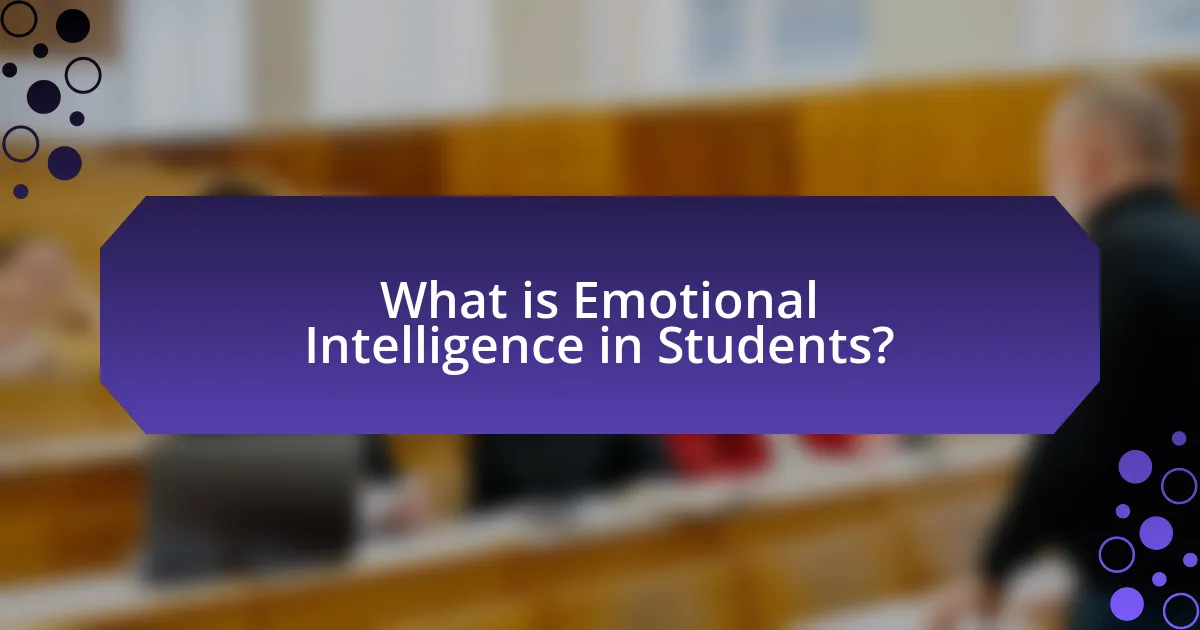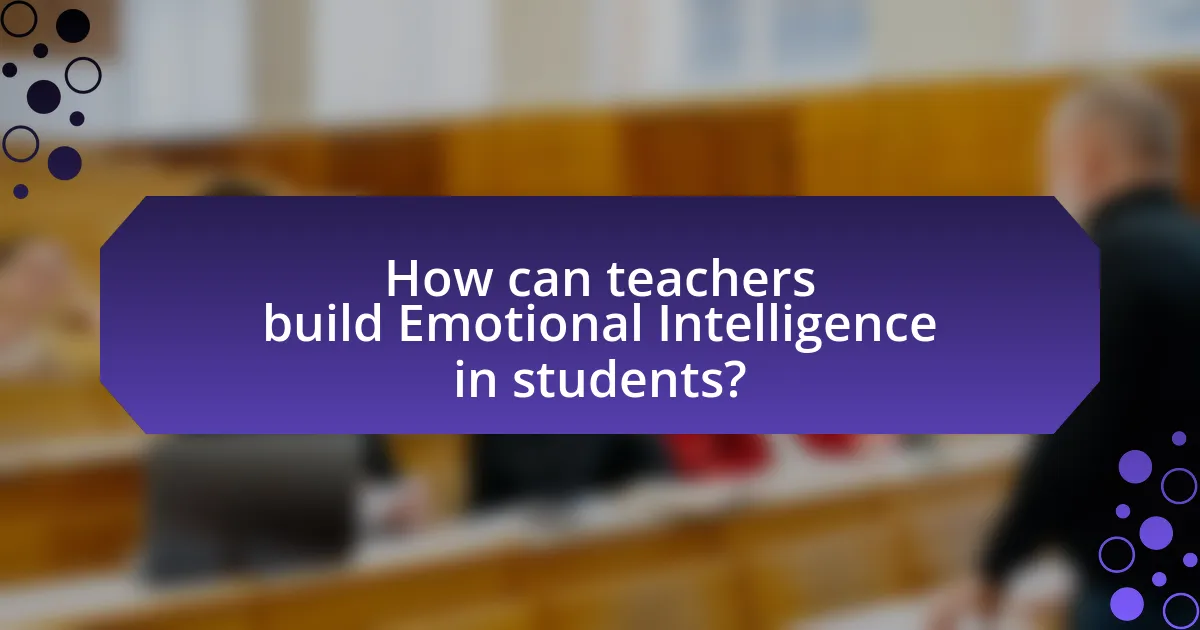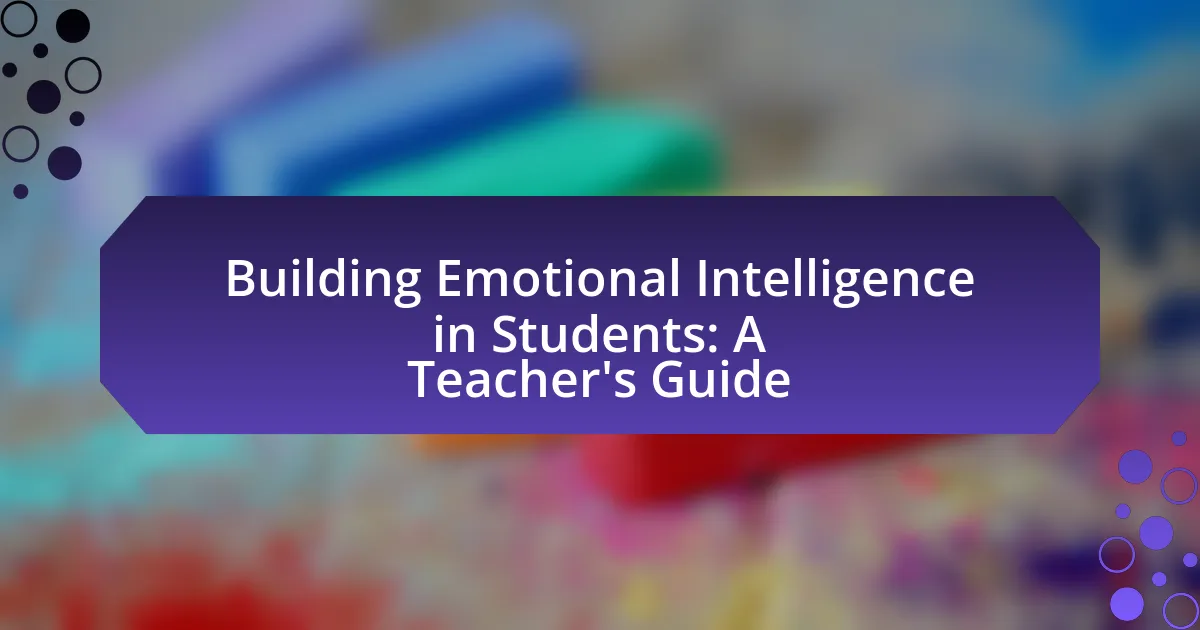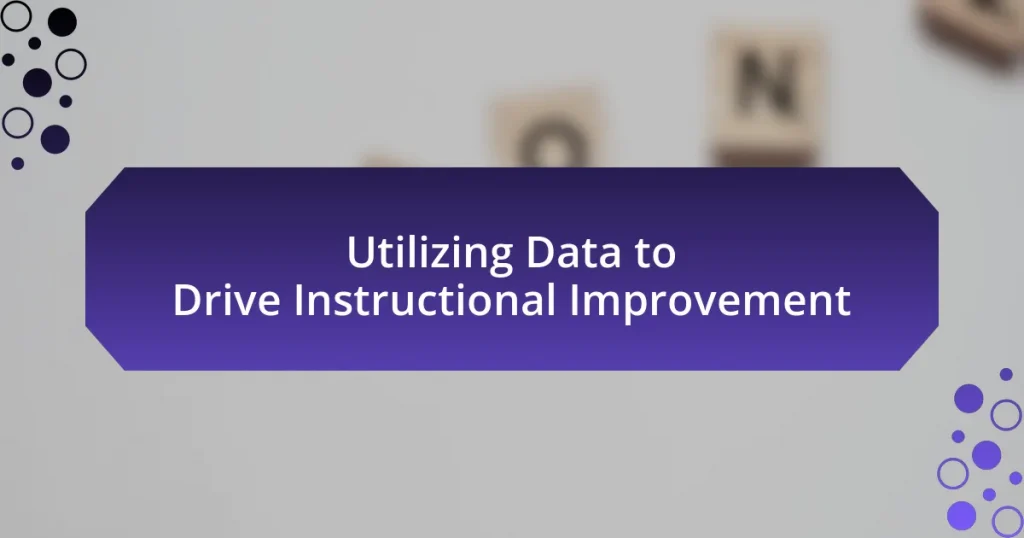Emotional intelligence in students encompasses the ability to recognize, understand, and manage their own emotions and those of others, which is vital for academic success and social interactions. This article outlines the definition of emotional intelligence within an educational context, its key components, and its distinction from traditional intelligence. It emphasizes the importance of emotional intelligence for students, detailing its positive impact on academic performance and social interactions. Additionally, the article provides strategies for teachers to foster emotional intelligence through social-emotional learning programs, role-playing activities, and mindfulness practices, while also addressing challenges and best practices for integration into the curriculum.

What is Emotional Intelligence in Students?
Emotional intelligence in students refers to the ability to recognize, understand, and manage their own emotions, as well as the emotions of others. This skill set is crucial for effective communication, empathy, and conflict resolution, which are essential for academic success and social interactions. Research indicates that students with high emotional intelligence tend to perform better academically and exhibit improved behavior in school settings, as they can navigate social complexities and manage stress more effectively. For instance, a study published in the Journal of Educational Psychology found that emotional intelligence is positively correlated with academic performance, highlighting its importance in the educational context.
How is Emotional Intelligence defined in an educational context?
Emotional Intelligence in an educational context is defined as the ability to recognize, understand, and manage one’s own emotions while also being able to recognize, understand, and influence the emotions of others. This definition emphasizes the importance of emotional awareness and regulation in fostering positive interactions and relationships within the school environment. Research indicates that students with high emotional intelligence tend to perform better academically, exhibit improved social skills, and demonstrate greater resilience in the face of challenges, highlighting its significance in educational settings.
What are the key components of Emotional Intelligence?
The key components of Emotional Intelligence are self-awareness, self-regulation, motivation, empathy, and social skills. Self-awareness involves recognizing one’s emotions and their impact on thoughts and behavior. Self-regulation refers to managing emotions and impulses effectively. Motivation encompasses the drive to pursue goals with energy and persistence. Empathy is the ability to understand and share the feelings of others, while social skills involve managing relationships and building networks. Research by Daniel Goleman, a prominent psychologist in the field, identifies these components as essential for effective interpersonal interactions and personal well-being.
How does Emotional Intelligence differ from traditional intelligence?
Emotional Intelligence (EI) differs from traditional intelligence (IQ) in that EI focuses on the ability to recognize, understand, and manage emotions in oneself and others, while traditional intelligence measures cognitive abilities such as reasoning, problem-solving, and knowledge acquisition. Research indicates that EI contributes significantly to personal and professional success, with studies showing that individuals with high emotional intelligence tend to have better interpersonal relationships and are more effective leaders. For example, a study by Goleman (1995) highlights that emotional competencies can be more important than IQ in determining success in the workplace.
Why is Emotional Intelligence important for students?
Emotional Intelligence is important for students because it enhances their ability to understand and manage their emotions, leading to better academic performance and interpersonal relationships. Research indicates that students with high emotional intelligence tend to have improved social skills, which facilitates collaboration and conflict resolution in group settings. Additionally, a study published in the Journal of Educational Psychology found that students with strong emotional intelligence scores achieved higher grades and exhibited lower levels of stress and anxiety. This correlation underscores the significance of emotional intelligence in fostering a supportive learning environment and promoting overall student well-being.
What impact does Emotional Intelligence have on academic performance?
Emotional Intelligence significantly enhances academic performance by improving students’ ability to manage emotions, foster relationships, and navigate social complexities. Research indicates that students with high Emotional Intelligence tend to exhibit better academic outcomes, as they are more adept at coping with stress, engaging in collaborative learning, and maintaining motivation. A study published in the Journal of Educational Psychology found that students with higher Emotional Intelligence scores achieved better grades and demonstrated improved problem-solving skills, highlighting the direct correlation between Emotional Intelligence and academic success.
How does Emotional Intelligence influence social interactions among students?
Emotional Intelligence (EI) significantly enhances social interactions among students by enabling them to understand and manage their own emotions while empathizing with others. Students with high EI are better equipped to navigate social complexities, leading to improved communication, conflict resolution, and collaboration. Research indicates that students with elevated emotional intelligence demonstrate stronger interpersonal skills, which fosters positive relationships and a supportive learning environment. For instance, a study published in the Journal of Educational Psychology found that students with higher EI scores reported better peer relationships and increased social competence, highlighting the direct correlation between emotional intelligence and effective social interactions.

How can teachers build Emotional Intelligence in students?
Teachers can build Emotional Intelligence in students by incorporating social-emotional learning (SEL) programs into their curriculum. These programs focus on developing skills such as self-awareness, self-regulation, empathy, and interpersonal skills. Research indicates that SEL programs can lead to improved academic performance and better emotional regulation among students. For instance, a meta-analysis by Durlak et al. (2011) found that students participating in SEL programs showed an 11 percentile-point gain in academic achievement compared to those who did not participate. By actively engaging students in discussions about emotions, modeling empathetic behavior, and providing opportunities for collaborative activities, teachers can effectively enhance their students’ emotional intelligence.
What strategies can teachers implement to enhance Emotional Intelligence?
Teachers can enhance Emotional Intelligence by incorporating social-emotional learning (SEL) programs into their curriculum. These programs focus on developing self-awareness, self-regulation, social awareness, relationship skills, and responsible decision-making. Research indicates that schools implementing SEL programs see improvements in students’ emotional skills, academic performance, and behavior. For instance, a meta-analysis by Durlak et al. (2011) found that students participating in SEL programs demonstrated an 11-percentile-point gain in academic achievement compared to those who did not. Additionally, teachers can model emotional intelligence by demonstrating empathy, active listening, and conflict resolution skills, which further reinforces these concepts in students.
How can role-playing activities foster Emotional Intelligence?
Role-playing activities can foster Emotional Intelligence by providing students with opportunities to practice empathy, self-regulation, and social skills in a safe environment. Through role-playing, students engage in scenarios that require them to understand and respond to the emotions of others, enhancing their ability to recognize emotional cues. Research indicates that experiential learning, such as role-playing, significantly improves emotional awareness and interpersonal skills, as it allows students to explore different perspectives and practice emotional responses in real-time situations. This method has been shown to increase emotional literacy, as students learn to articulate their feelings and understand the feelings of others, ultimately contributing to their overall emotional intelligence development.
What role does mindfulness play in developing Emotional Intelligence?
Mindfulness plays a crucial role in developing Emotional Intelligence by enhancing self-awareness and emotional regulation. Practicing mindfulness allows individuals to observe their thoughts and feelings without judgment, which fosters a deeper understanding of their emotional responses. Research indicates that mindfulness training can lead to significant improvements in emotional regulation, empathy, and social skills, all of which are key components of Emotional Intelligence. For instance, a study published in the journal “Emotion” by Keng, Smoski, and Robins found that mindfulness practices are associated with increased emotional awareness and improved interpersonal relationships, thereby supporting the development of Emotional Intelligence.
What resources are available for teachers to support Emotional Intelligence development?
Teachers can access various resources to support Emotional Intelligence (EI) development, including curricula, training programs, and literature. Programs like the Collaborative for Academic, Social, and Emotional Learning (CASEL) provide frameworks and materials for integrating EI into classroom practices. Additionally, books such as “Emotional Intelligence 2.0” by Travis Bradberry and Jean Greaves offer insights and strategies for fostering EI in students. Online platforms like Edutopia and the Greater Good Science Center also provide articles, videos, and lesson plans focused on EI development. These resources are validated by research indicating that EI education enhances student outcomes, including academic performance and social skills.
Which books and materials are recommended for teaching Emotional Intelligence?
Recommended books and materials for teaching Emotional Intelligence include “Emotional Intelligence 2.0” by Travis Bradberry and Jean Greaves, which provides practical strategies for developing emotional skills. Another essential resource is “The Emotionally Intelligent Teacher” by Marcia Hughes and James Terrell, offering insights specifically for educators. Additionally, “Social Intelligence: The New Science of Human Relationships” by Daniel Goleman explores the social aspects of emotional intelligence. For practical activities, “The EQ Edge: Emotional Intelligence and Your Success” by Steven J. Stein and Howard E. Book provides exercises and assessments. These resources are widely recognized in the field and have been utilized in various educational settings to enhance emotional intelligence among students.
How can technology be utilized to promote Emotional Intelligence in the classroom?
Technology can be utilized to promote Emotional Intelligence in the classroom by integrating tools that facilitate social-emotional learning (SEL). For instance, applications like ClassDojo and Mood Meter allow students to express their feelings and reflect on their emotions, fostering self-awareness and empathy. Research indicates that using digital platforms for role-playing scenarios enhances students’ ability to recognize and manage emotions, which is a core component of Emotional Intelligence. Furthermore, online collaboration tools encourage teamwork and communication, essential skills for developing interpersonal relationships. These technological interventions have been shown to improve students’ emotional regulation and social skills, thereby supporting their overall emotional development in educational settings.

What challenges do teachers face in promoting Emotional Intelligence?
Teachers face several challenges in promoting Emotional Intelligence, including a lack of training, insufficient resources, and varying student needs. Many educators report feeling unprepared to teach Emotional Intelligence due to limited professional development opportunities focused on this area. Additionally, schools often lack the necessary materials and curricula to effectively integrate Emotional Intelligence into their teaching practices. Furthermore, the diverse emotional and social backgrounds of students can complicate the implementation of Emotional Intelligence programs, as teachers must tailor their approaches to meet individual needs. Research indicates that these factors can hinder the successful promotion of Emotional Intelligence in educational settings.
What common obstacles hinder the development of Emotional Intelligence in students?
Common obstacles that hinder the development of Emotional Intelligence in students include a lack of supportive environments, insufficient emotional literacy education, and cultural stigmas surrounding emotional expression. Supportive environments are crucial; without them, students may struggle to practice and develop their emotional skills. Research indicates that educational settings that prioritize emotional learning significantly enhance students’ emotional intelligence, as seen in studies by the Collaborative for Academic, Social, and Emotional Learning (CASEL). Additionally, when emotional literacy is not integrated into curricula, students miss opportunities to learn essential skills such as empathy and self-regulation. Cultural stigmas can further discourage students from expressing emotions, leading to a suppression of emotional development. These factors collectively impede the growth of emotional intelligence in educational contexts.
How can teachers address resistance from students or parents regarding Emotional Intelligence training?
Teachers can address resistance from students or parents regarding Emotional Intelligence training by actively engaging them in discussions about the benefits of such training. Research indicates that Emotional Intelligence can lead to improved academic performance and better social interactions, which can alleviate concerns. By providing evidence from studies, such as those conducted by the Collaborative for Academic, Social, and Emotional Learning (CASEL), teachers can demonstrate how Emotional Intelligence skills enhance students’ overall well-being and success. Additionally, involving parents in the training process through workshops or informational sessions can foster a collaborative environment, making them more receptive to the initiative.
What strategies can be employed to overcome time constraints in the curriculum?
To overcome time constraints in the curriculum, educators can implement strategies such as prioritizing essential content, integrating interdisciplinary approaches, and utilizing technology for efficiency. Prioritizing essential content ensures that the most critical aspects of emotional intelligence are covered, allowing teachers to focus on key skills like self-awareness and empathy. Integrating interdisciplinary approaches, such as combining emotional intelligence lessons with social studies or literature, can maximize instructional time by reinforcing concepts across subjects. Additionally, utilizing technology, such as online resources and interactive platforms, can streamline lesson delivery and provide students with flexible learning opportunities, thus making the most of limited classroom time. These strategies are supported by research indicating that focused and integrated teaching methods enhance student engagement and learning outcomes.
How can teachers assess the Emotional Intelligence of their students?
Teachers can assess the Emotional Intelligence of their students through various methods, including self-report questionnaires, peer assessments, and observational techniques. Self-report questionnaires, such as the Emotional Quotient Inventory (EQ-i), allow students to evaluate their own emotional skills and awareness. Peer assessments involve students providing feedback on each other’s emotional behaviors and interactions, which can highlight social awareness and relationship management. Observational techniques enable teachers to monitor students’ emotional responses in real-time during classroom activities, providing insights into their emotional regulation and empathy. Research indicates that these methods can effectively gauge emotional intelligence, as they encompass both self-perception and social dynamics, crucial components of emotional intelligence.
What tools and methods are effective for measuring Emotional Intelligence?
Effective tools and methods for measuring Emotional Intelligence include self-report questionnaires, ability-based assessments, and 360-degree feedback instruments. Self-report questionnaires, such as the Emotional Quotient Inventory (EQ-i) and the Trait Emotional Intelligence Questionnaire (TEIQue), allow individuals to assess their own emotional skills and competencies. Ability-based assessments, like the Mayer-Salovey-Caruso Emotional Intelligence Test (MSCEIT), evaluate an individual’s capacity to process emotional information and apply it to everyday situations. Additionally, 360-degree feedback instruments gather insights from peers, supervisors, and subordinates, providing a comprehensive view of an individual’s emotional intelligence in various contexts. These methods are validated through extensive research, demonstrating their reliability and effectiveness in measuring emotional intelligence across different populations.
How can feedback be used to improve students’ Emotional Intelligence?
Feedback can be used to improve students’ Emotional Intelligence by providing specific, constructive insights that help them recognize and understand their emotions and the emotions of others. When teachers offer feedback that highlights emotional responses in various situations, students learn to identify their feelings and the feelings of their peers, fostering empathy and self-awareness. Research indicates that targeted feedback can enhance emotional regulation skills, as it encourages students to reflect on their emotional experiences and responses, ultimately leading to improved interpersonal skills and emotional understanding. For instance, a study published in the Journal of Educational Psychology found that students who received feedback focused on emotional aspects showed significant growth in their emotional competencies compared to those who did not receive such feedback.
What are best practices for integrating Emotional Intelligence into the curriculum?
Best practices for integrating Emotional Intelligence into the curriculum include incorporating social-emotional learning (SEL) frameworks, providing professional development for educators, and embedding emotional intelligence skills into existing subjects. Research shows that SEL programs can improve students’ emotional regulation and academic performance, with a meta-analysis by Durlak et al. (2011) indicating that students participating in SEL programs demonstrated an 11 percentile-point gain in academic achievement compared to those who did not. Additionally, creating a safe and supportive classroom environment encourages open discussions about emotions, fostering a culture of empathy and understanding among students. Regularly assessing students’ emotional skills through surveys or reflections can also help tailor the curriculum to meet their needs effectively.
How can teachers create a classroom environment that nurtures Emotional Intelligence?
Teachers can create a classroom environment that nurtures Emotional Intelligence by fostering open communication, promoting empathy, and encouraging self-awareness among students. Establishing a culture of trust allows students to express their feelings and thoughts without fear of judgment, which is essential for developing emotional skills. Incorporating activities such as role-playing and group discussions helps students practice empathy by understanding different perspectives. Additionally, integrating mindfulness practices can enhance self-awareness, enabling students to recognize and manage their emotions effectively. Research indicates that classrooms emphasizing social-emotional learning lead to improved academic performance and better interpersonal relationships, highlighting the importance of these strategies in nurturing Emotional Intelligence.
What activities can be incorporated into daily lessons to enhance Emotional Intelligence?
Incorporating activities such as role-playing, mindfulness exercises, and group discussions into daily lessons can significantly enhance Emotional Intelligence. Role-playing allows students to practice empathy by stepping into others’ shoes, which fosters understanding of different perspectives. Mindfulness exercises, such as deep breathing or meditation, help students become more aware of their emotions and improve self-regulation. Group discussions encourage open communication and active listening, essential components of emotional awareness and social skills. Research indicates that these activities can lead to improved emotional regulation and interpersonal skills among students, as evidenced by studies showing that social-emotional learning programs can increase students’ emotional intelligence by up to 23%.



